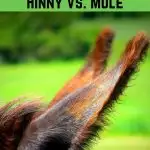As humans domesticated horses, they experimented with various equine hybrids. We are always looking for different varieties of horses and donkeys to best suit our needs – so what happens when you breed a horse and a donkey? The resulting animal is a mule – or a hinny!
Here are 11 interesting facts you may not know about these hinnies and mules.
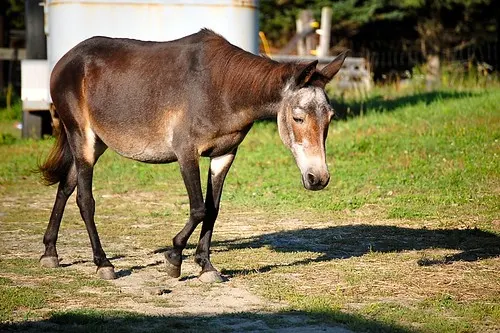
Table of Contents
1. Mules and Hinnies Are Not the Same Animals
Both mules and hinnies are “hybrid” equines. Hybrid offspring are the products of breeding two different species: in this case, horses and donkeys.
- Hinny: The offspring of a male horse (stallion) and a female donkey (jenny).
- Mule: The offspring of a female horse (mare) and a male donkey (jack).
The term “mule” can still casually refer to any donkey/horse hybrid. However, mules and hinnies are suited for different purposes, as they have slightly different characteristics.
2. However, They Often Look Identical
It can be difficult to tell mules and hinnies apart from one another. They often look very similar, but a discerning eye can pick up on the differences.
In general, hinnies are smaller in stature than mules. The height of a mule or a hinny can vary widely, depending on what breed of horse or donkey it comes from. There are three general sizes of mules:
- Miniature: Measures less than 50” tall at the withers, or around 12 hands.
- Saddle mule: Measures more than 50” tall. The standard size for a pony is below 14.2 hands. A mule suitable for riding should be tall enough to support a rider, and will generally measure about 13-16 hands.
- Draft mule: Donkeys crossed with draft horses produce a tall, strong mule suitable for riding or farm work.
Hinnies tend to have smaller ears and a more “horse-like” face, and a coat color that resembles the stallion’s.
Now, scientists and breeders can use DNA testing to determine whether an animal is a mule or a hinny. They can evaluate the behavior and temperament of these animals and further select desirable characteristics.
3. They Behave Differently
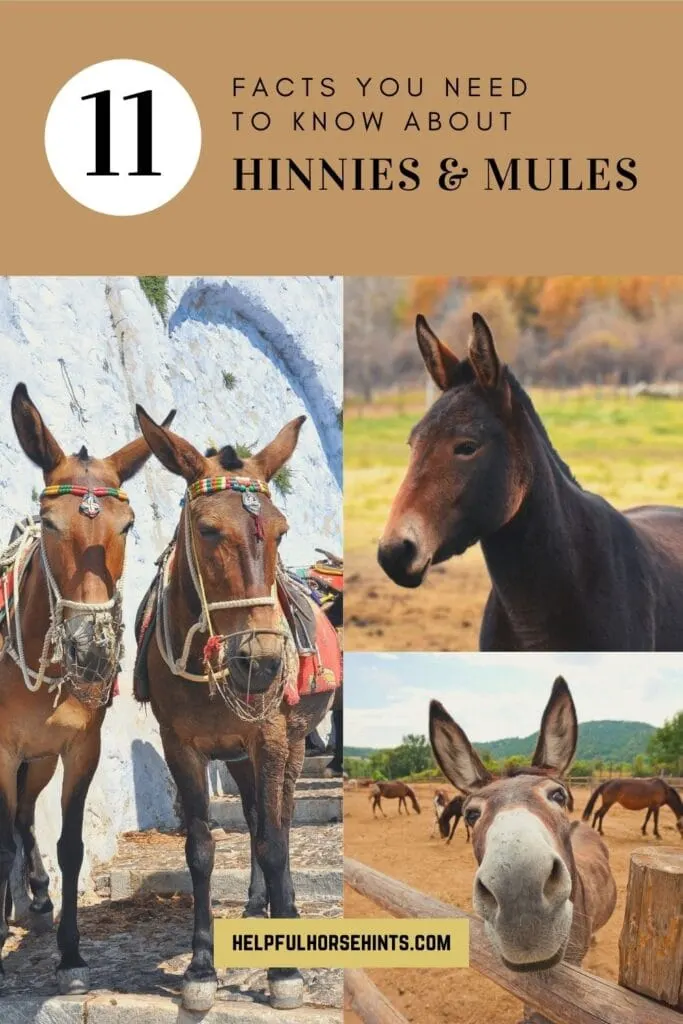
Even though mules and hinnies may look alike, their behavior can often help you tell the difference.
In general, hinnies tend to behave more like their jenny mothers: they have quieter temperaments, they move more slowly than mules, and they tend to do things in a more thoughtful “donkey” way. This can make them seem stubborn and unpredictable, but they aren’t prone to spooking.
Mules, on the other hand, act more like horses. Mules tend to be more energetic, agile, and bold, especially out on a trail. This is helpful if you need a confident riding partner – not so much if you need a quiet pack mount.
4. They Aren’t Always Sterile
It’s a well-known fact that mules and hinnies can’t usually reproduce. It all comes down to chromosomes: in mammals, each parent provides half of the chromosomes necessary to produce a viable offspring.
Horses have 64 chromosomes, but donkeys only have 62. Together, their offspring ends up with 63. Thankfully, having an extra chromosome doesn’t affect the baby negatively, except when it comes to reproduction.
Normally, having an extra pair of chromosomes means that the mule or hinny cannot reproduce on their own. However, there have been recorded cases of mules giving birth. Even though the odds are against them, it is still technically possible for a mule or a hinny to have a baby of their own.
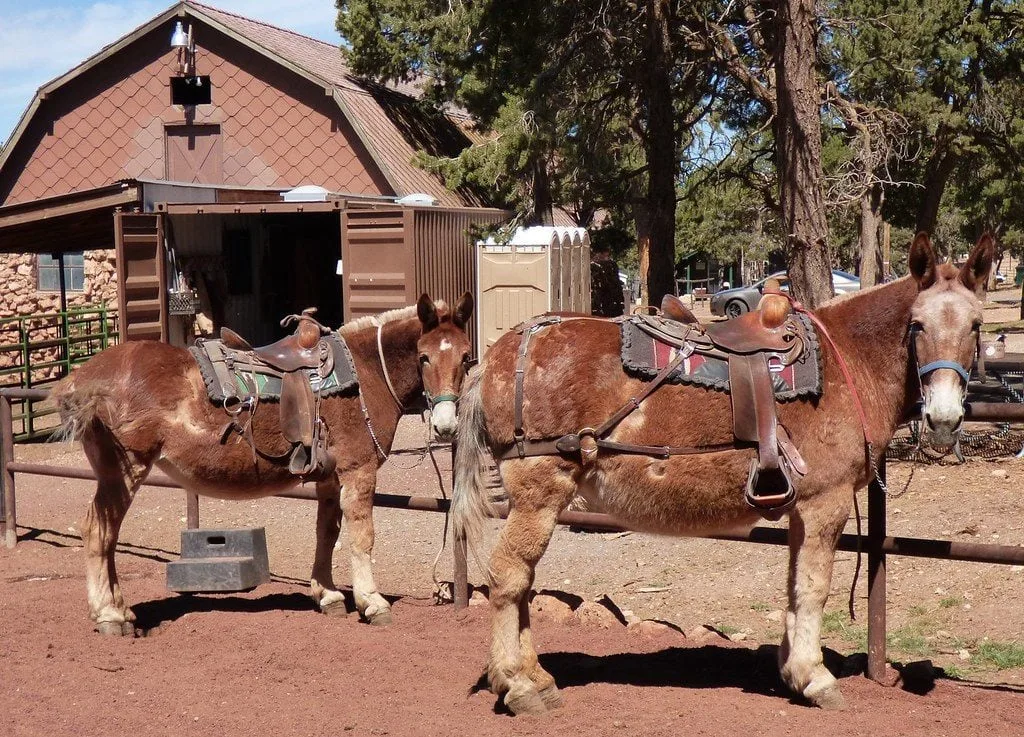
5. Mules Are More Popular Than Hinnies
Mules are generally created on purpose. They are strong and comfortable enough for riding, and generally have good temperaments.
Hinnies are usually conceived by accident. Hinnies are less popular because people think they have bad attitudes, and it can be more difficult for a jenny to conceive and give birth.
Donkeys also tend to have longer gestation periods than horses, and the size of the stallion is important for the health and safety of the jenny (and the foal).
Because of these factors, breeders are less likely to spend time cultivating hinnies and focus on refining mules instead.
6. Hinnies Are Still Useful!
Even though they’re less popular, hinnies have some positive attributes that can make them attractive for enthusiasts. They are common ranch animals outside of the US in countries like Brazil, Columbia, and Portugal.
Hinnies are less discerning than mules when it comes to foraging. They’ll likely eat a wider variety of plants, which means they can subsist in regions where vegetation is sparse (such as rocky mountain areas in high altitudes).
They’re also more careful on trails than mules, but they are just as muscular – hinnies often possess the size and strength of a horse. This makes them great pack animals. Although they may take their time, a hinny won’t tire as quickly as a mule.
Because hinnies are often just as strong and intelligent as mules, they can be used for riding or driving as well.
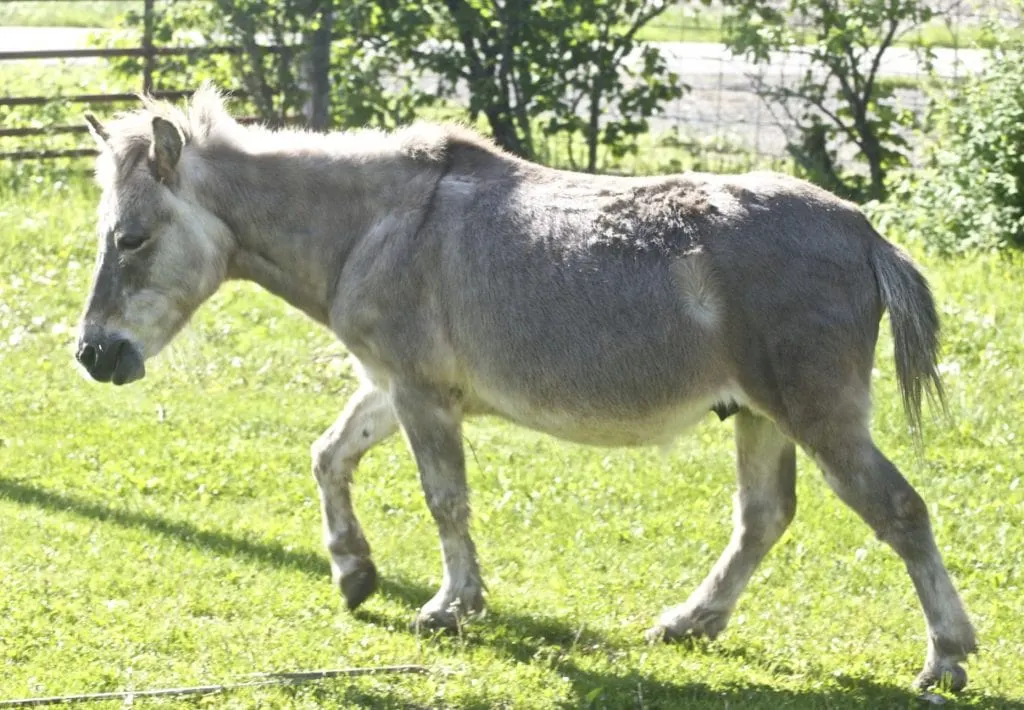
7. They Both Have Unfair Reputations
Mules are known for their stubbornness. Ever heard the phrase, “stubborn as a mule?” Hinnies have even worse reputations for being obstinate, which is sometimes why breeders are cautious to create them.
However, both animals are just as intelligent as horses and donkeys, and they have a strong sense of self-preservation. They aren’t willing to follow you into a dangerous situation – and why should they? This is why their intelligence is often mistaken for stubbornness.
With trust, patience, and knowledge, you can convince a mule or a hinny that your idea is a good idea. But if you mistreat them, they’ll be a lot less likely to follow your directions.
8. Equines of Many Colors
Mules and hinnies come in a variety of shades, just like horses. The most common coat colors are sorrel, brown, black, and bay. Lesser common colors include white, palomino, dun, buckskin.
Even rarer still are painted or spotted mules, but they do exist. A mule with stripes probably isn’t a mule at all, but likely a cross between a zebra and a donkey!
9. Healthy, Wealthy, and Wise
Both mules and hinnies are known for their long lives and hardiness. Hybrid crosses between species can have something called “hybrid vigor,” in which offspring get the best traits from both parents.
For mules, this is strength and agility. For hinnies, this is surefootedness and thoughtfulness. Both hybrids have strong feet, excellent endurance, and gentle temperaments. If you treat them well, they can both outlive most horses and thrive well into their 30s, 40s, and beyond!
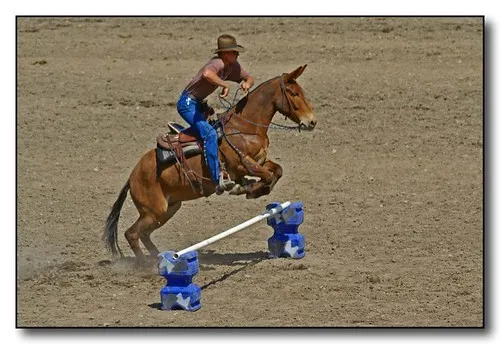
10. Gaited Mules and Hinnies
Did you know that both of these equine hybrids can be gaited? Gaited horses perform a variety of movements outside the standard walk, trot, and canter. The running walk, pace, and rack are all common for gaited horses.
Hybrid equines often inherit these gaited abilities from their horse parents, especially if the horse breed is well-known for it. Paso Finos, for example, can make great mule parents. They’re small, gentle, and comfortable to ride, too!
A gaited hinny is preferable in a rocky environment where there’s little chance for galloping – hinnies aren’t racehorses. But, a gaited hinny could have a smooth, ground-covering gait instead.
11. They Can Compete in Dressage!
Mules and hinnies compete in all sorts of competitions that were traditionally reserved for horses. While they are barred from the upper levels of hunter and jumper competitions (except at mule specific shows, where they often excel), mules can compete in USDF dressage events. They even occasionally compete in the finals in Kentucky!
Is it a mule, or is it a hinny?
Overall, it can be difficult to tell the difference between a mule and a hinny. Because mules are more popular than hinnies, the odds are good that it’s a mule.
If you’re interested in an equine companion with the strength and size of a horse, but the easy-going and gentle nature of a donkey, a hinny or a mule will serve you well. At the end of the day, the most important factor is finding a companion that suits your specific needs.
Related Posts
- Donkey vs. Mule vs. Hinny: A Look at the Differences
- 11 Facts About Zebra, Donkey’s and Horses
- 15 Fruits and Vegetables Horses Love to Eat
Source:
- https://www.bnd.com/living/liv-columns-blogs/answer-man/article135296594.html

